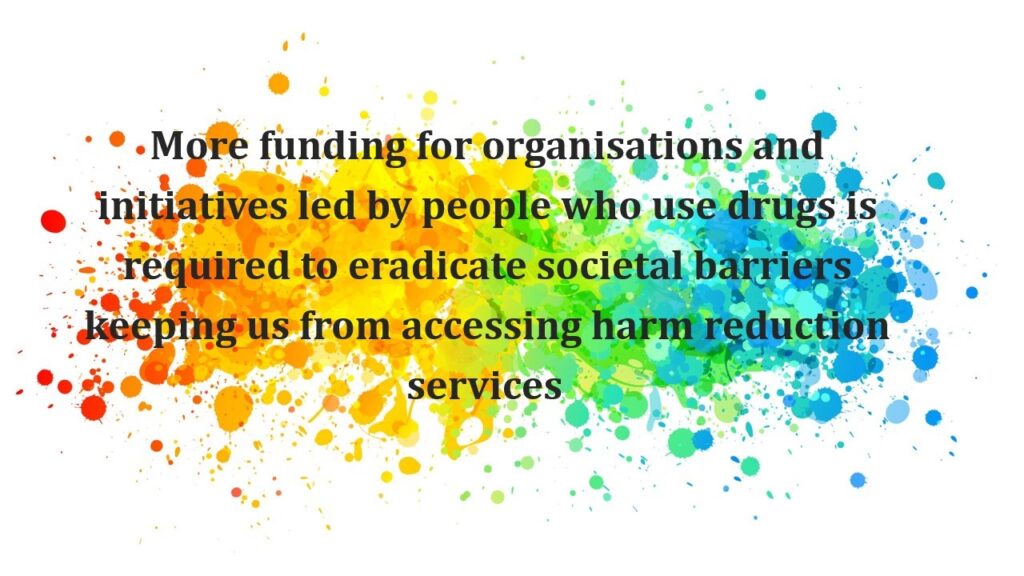
More funding for organisations and initiatives led by people who use drugs is required to eradicate societal barriers keeping us from accessing harm reduction services. Actions that need to be taken both in the long term and short term for women who use drugs include:
- Scale up of gender-sensitive harm reduction services and remove abstinence as condition for access to services.
- Government action and funding to support the advocacy for both the removal of punitive and discriminatory laws and the introduction of enabling laws.
- There must be accessible judicial and other accountability mechanisms, community monitoring of human rights abuses, peer education on human rights and the ability to advocate for policy and law reform
- Community-led monitoring is a robust and systematic strategy to identify, analyse and advocate to eliminate the human rights barriers by communities in partnership with stakeholders
Disparities between need and funding for key populations
The most recent finding from the Funders Concerned About AIDS (FCAA) has documented a glaring disparity between need and available resources for key populations. They have found that only 15% of the HIV philanthropy funding for 2020 was spent on people key populations. The report quotes the 2021 UNAIDS Global HIV and AIDS Statistics which has found that people who inject drugs are 3 times more likely to acquire HIV than the general population. However, according to the FCAA funding report the HIV-Related Philanthropy for people who use drugs has seen a decrease from $20 million in 2016 to $17 million in 2020. In a context where key populations and their partners account for 70% of the HIV infections globally, this decrease funding allocation is costing lives, including those of women who use drugs.
Women additionally navigate intersectional barriers
Though all people who use drugs must live under and endure the harms caused by prohibition, punitive laws and policies, stigma and discrimination, women as people who use drugs must additionally navigate intersectional barriers of gender-blind policy development and punitive drug policies. This further marginalises women and makes them invisible in policy design and implementation with diminished support and funding for their initiatives. Less women access available harm reduction measures and treatment, with only 10% of women who use drugs in treatment even though they have a higher prevalence of HIV and HCV (hepatitis C virus). More disappointing when seen in the light of a third of people who use and inject drugs are women.
More funding for gender efforts by women to eradicate societal barriers
Funding and advocacy support for the women led initiatives for the removal of societal barriers, both social and structural, is necessary to eradicate the stigma and discrimination that informs the stripping of the human rights of women who use drugs. The design of harm reduction services must be informed by the lifestyles of women, because current gender-blind services are inadequate and inappropriate. More effort must be made to fund the gender sensitive harm reduction measures started by women for women to plug these gaps. The moral judgment of women who use drugs leaves them vulnerable to exclusion from mainstream health services with forced treatment sometimes a condition for access to these.
Inclusion of women in fully policy cycle
State sponsored services and morally judgmental narratives tend to pathologise the choices of women to use drugs leaving them at risk of losing some of their basic rights. Their right to parent their children, access universal social services and seek legal protection are made conditional to their stopping to use drugs. Moreover, when women experience private and public violence their choice to use drugs is seen as a contributing factor. This means that the services that other women can access are not available to them.
For women to fight for the reinstatement of their rights they need to be present in the conversations about them, the policies that affect them and give feedback on the impact of these. The findings of the Funders Concerned About AIDS show that there has been a preference for advocacy funding, with it accounting for more than 50% of all HIV-related philanthropy for key populations. Although drug user led organisations, and advocacy initiatives are seeing a real decrease in their funding, which will mean little of this allocation goes to them.
Continued decriminalisation has negative impact on funding women’s organisations
With the continued criminalisation of the use and possession of drugs in most countries, women who use drugs face the threat of imprisonment or forced treatment. Having to hide their choice to use drugs, where they use drugs and which drugs, silences the voices of women in the conversations about the many diverse reasons they choose to use drugs. Criminalisation has had a negative impact on the funding of key population-led organisations, as there is little government and public support for allocating funding for communities that are criminalised and seen to be deserving of punishment.
COVID-19 has shown us more than ever that health does not exist in a vacuum and a person’s ability to protect themselves depends on their access to resources, reliable and evidence-based information from trusted sources and individual and community empowerment. The allocation of funding must seek out and support drug user-led networks, including women-led initiatives to ensure that they become sustainable, can pay for their employees, and continue to provide services to women who use drugs.